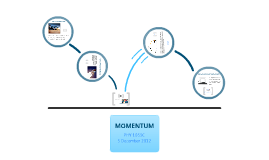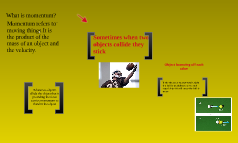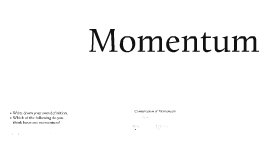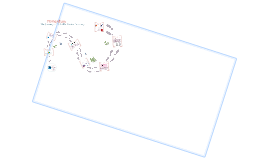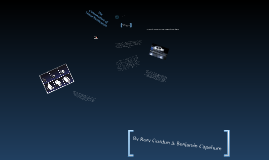Momentum
Transcript: Momentum Newton's Second Law foce = mass x acceleration The law of conservation of linear momentum is a fundamental law of nature, and it states that if no external force acts on a closed system of objects the momentum of the closed system remains constant. An example of momentum would be a car crash. Car designers have introduced safety features to minimise the impact on humans. One example of this would be crumple zones, also known as a crush zone, are areas of a vehicle that are designed to deform and crumple in a collision. This absorbs some of the energy of the impact, preventing it from being transmitted to the occupants. Like it or not, physics has the explanation as to why crumple zones are necessary. Isaac Newton's first law states that an object in motion will stay in motion with the same speed and in the same direction unless acted upon by an unbalanced force. If a vehicle is traveling at 50 mph, so are the bodies inside and if this vehicle stops abruptly into a solid wall, the bodies will “feel” the need to keep going in the same direction at 50 mph, unless of course something stops them. What's more, even if the bodies themselves stop, the internal organs will continue to move, thus causing severe injuries. We're still not out of the physics woods yet. There's another law, the second, from the same Newton saying that force equals mass multiplied by acceleration. Translated to our situation, that of an accident, it means that the force experienced by the automobile and its occupants decreases if the time required by the vehicle to stop increases. Like seat belts, the concept of the airbag -- a soft pillow to land against in a crash -- has been around for many years. The first patent on an inflatable crash-landing device for airplanes was filed during World War II. In the 1980s, the first commercial airbags appeared in automobiles. The Conservation of Linear Momentum The principle that the linear momentum of a system has constant magnitude and direction if the system is subjected to no external force FIRING A RIFLE: The conservation of linear momentum is reflected in operations as simple as the recoil of a rifle when it is fired, and in those as complex as the propulsion of a rocket through space. In accordance with the conservation of momentum, the momentum of a system must be the same after it undergoes an operation as it was before the process began. Before firing, the momentum of a rifle and bullet is zero, and therefore, the rifle-bullet system must return to that same zero-level of momentum after it is fired. Thus, the momentum of the bullet must be matched—and "cancelled" within the system under study—by a corresponding backward momentum. When a person shooting a gun pulls the trigger, it releases the bullet, which flies out of the barrel toward the target. The bullet has mass and velocity, and it clearly has momentum; but this is only half of the story. At the same time it is fired, the rifle produces a "kick," or sharp jolt, against the shoulder of the person who fired it. This backward kick, with a velocity in the opposite direction of the bullet's trajectory, has a momentum exactly the same as that of the bullet itself: hence, momentum is conserved. ROCKETING THROUGH SPACE: Contrary to popular belief, rockets do not move by pushing against a surface such as a launchpad. If that were the case, then a rocket would have nothing to propel it once it had been launched, and certainly there would be no way for a rocket to move through the vacuum of outer space. Instead, what propels a rocket is the conservation of momentum. Upon ignition, the rocket sends exhaust gases shooting downward at a high rate of velocity. The gases themselves have mass, and thus, they have momentum. To balance this downward momentum, the rocket moves upward—though, because its mass is greater than that of the gases it expels, it will not move at a velocity as high as that of the gases. Once again, the upward or forward momentum is exactly the same as the downward or backward momentum, and linear momentum is conserved. By Rory Gordon & Benjamin Capehorn f = ma






